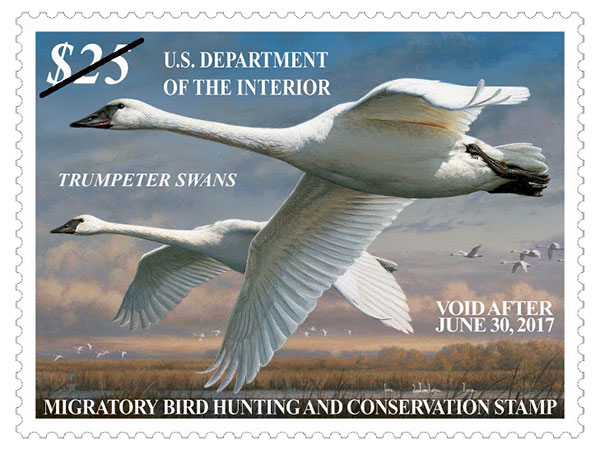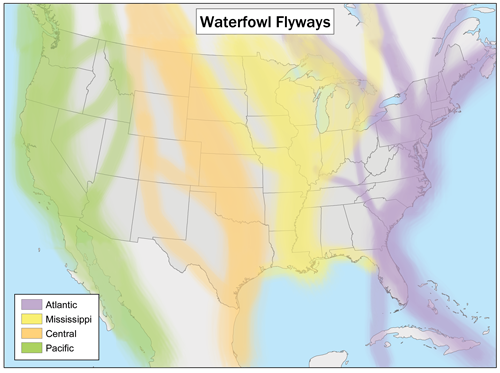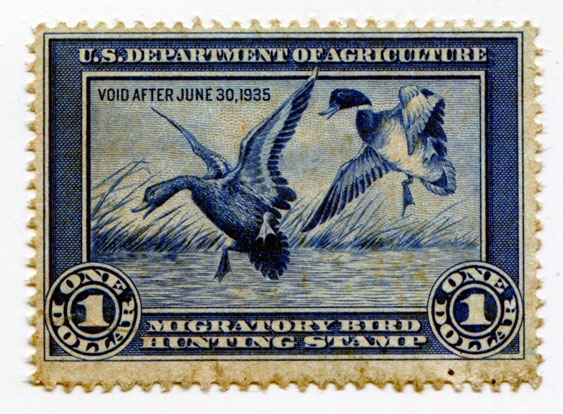The Migratory Bird Hunting and Conservation Stamp (often called the “Duck Stamp”) is an easy, cost-effective way for hunters, birders, environmental educators, and other conservationists to make a tangible contribution that will protect natural habitat for the benefit of migratory birds and other wildlife. Money collected from sales of the Stamp goes directly into a fund set aside specifically for expansion of the federal National Wildlife Refuge system.

A Stamp for the 2018-2019 season costs $25. While purchase of an annual Stamp is required of all hunters (age 16 and up) of migratory waterfowl, the Stamp is desired by philatelists and collectors of art, and it’s chosen by birders and other enthusiasts of nature as a way to show their support.
Stamp fees are collected in the Migratory Bird Conservation Fund (MBCF), and are disbursed from the fund to protect wetlands and other natural areas through direct land purchase, leases, and conservation easements. Virtually all of the purchase price of each Stamp (98%) is applied to conserving habitat.
Since the Stamp’s inception in 1934, portions of 252 National Wildlife Refuges (accounting for more than 2.37 million acres) and over 200 Waterfowl Production Areas (over 3.0 million acres) have been secured via investments made through the MBCF. Mostly, these have been wetland, bottomland, and grassland habitats. Cumulatively, Stamp sales have raised the better part of $1 billion for the protection of wildlife.

Migratory birds—be they waterfowl, shorebirds, long-legged waders, raptors, songbirds, or other groups—require stopover sites as they make their way north each spring to their breeding grounds throughout North America, and then again on their return to wintering areas. Following instinct and other cues, the birds follow well-established routes, known as flyways. The Refuge System provides a series of National Wildlife Refuges (NWRs), aligned with the flyways, where birds can rest and refuel before continuing their long-distance journeys.
Just as important, smaller but more numerous parcels of land, located mostly in the northern Great Plains, protect wetlands that ducks and their kin employ for breeding habitat. These tracts, sometimes no larger than 100 acres, are organized into Wetland Management Districts, and are designated Waterfowl Production Areas (WPAs). They’re very well named: this so-called Prairie Pothole Region is the birthplace of 50% of North America’s waterfowl.
Other species of birds (among them the beloved Snow Goose) depend on NWRs as safe havens to spend the cold weather months.
And it’s not just birds that benefit from NWRs. The diverse wetlands, uplands, prairies, and open water habitats provided by Refuges safeguard water quality, as well as populations of amphibians and reptiles; mammals; fishes; butterflies, dragonflies, and other insects; and native plants. There’s a refuge in Oregon that is specifically designated to shelter pronghorn antelope.

The first Stamp, issued for the 1934 hunting season, was designed by J.N. “Ding” Darling, Director of the Bureau of Biological Survey (the forerunner of the U.S. Fish and Wildlife Service, caretaker of the Refuge System). In the early years, artists like Robert W. “Bob” Hines and Maynard Reece provided drawings and paintings that were reproduced as Stamps. In the 1950s, the agency opened up the process of designing each year’s stamp to the nation’s art community, and two years later it held the first annual formal selection with prescribed guidelines for submissions. Today the Federal Duck Stamp Art Contest, open to the public, is the only juried art competition sponsored by the federal government.
A companion contest and curriculum for students, the Junior Duck Stamp Conservation Program, teaches youngsters about wetland and waterfowl conservation, along with rewarding artistic skill and expression.
The Stamp is your annual “free pass” to visit any of the country’s refuges that collect user fees—quite a bargain at $25! It’s collectible art that fits in your pocket. Even better, you can slip the Stamp into a transparent plastic holder, clip it onto your gear, and show everyone that you support conservation and preserving our natural bequest to future generations. Stamps are available from the Postal Service, at select post offices and NWR offices, and at many large hunting and sporting goods retailers. The Stamp may not be valid for postage, but when it comes to habitat preservation, it’s ever so valuable. Go and get your Stamp!
The Friends of the Migratory Bird/Duck Stamp have one job: to promote the Stamp. Join us, and help spread the word!